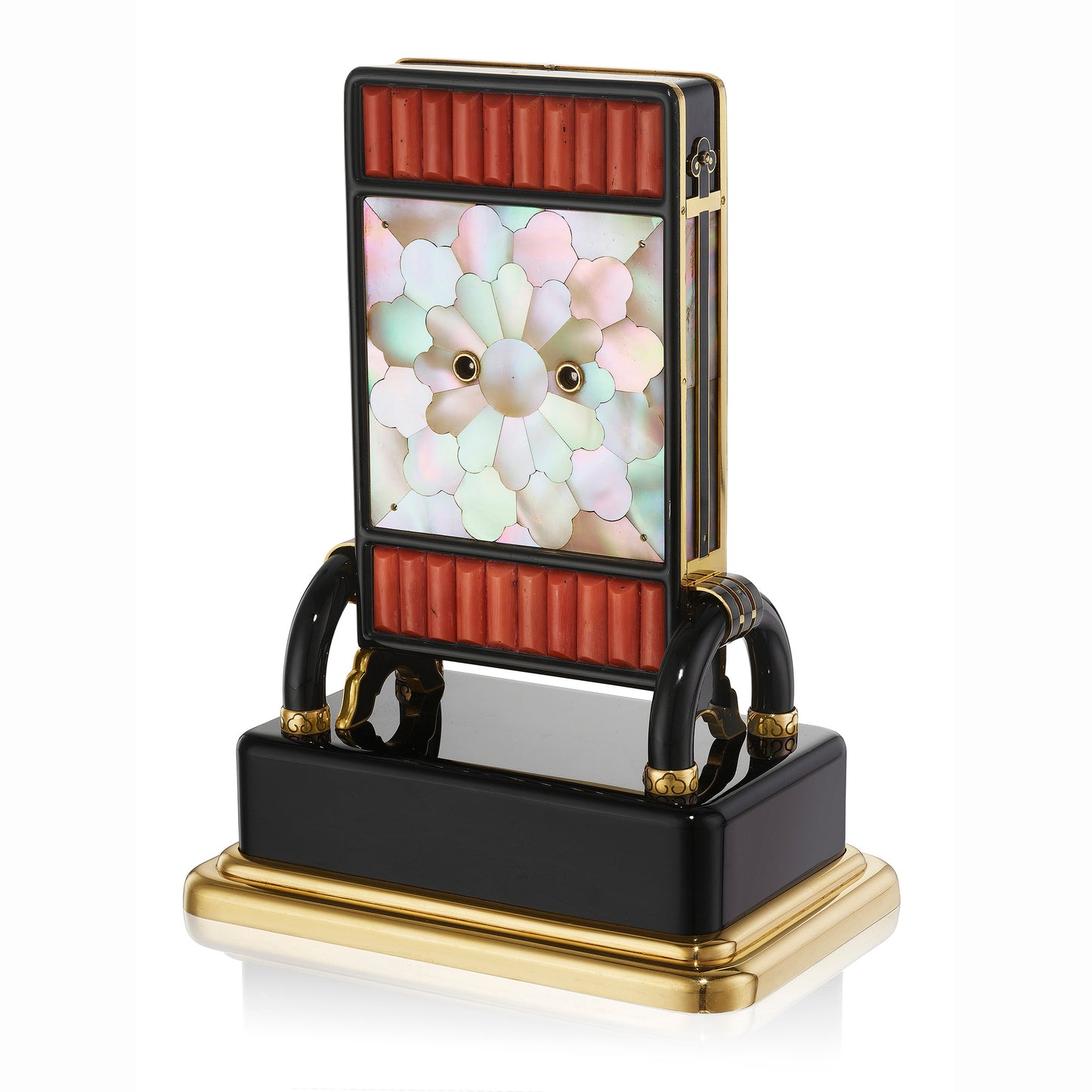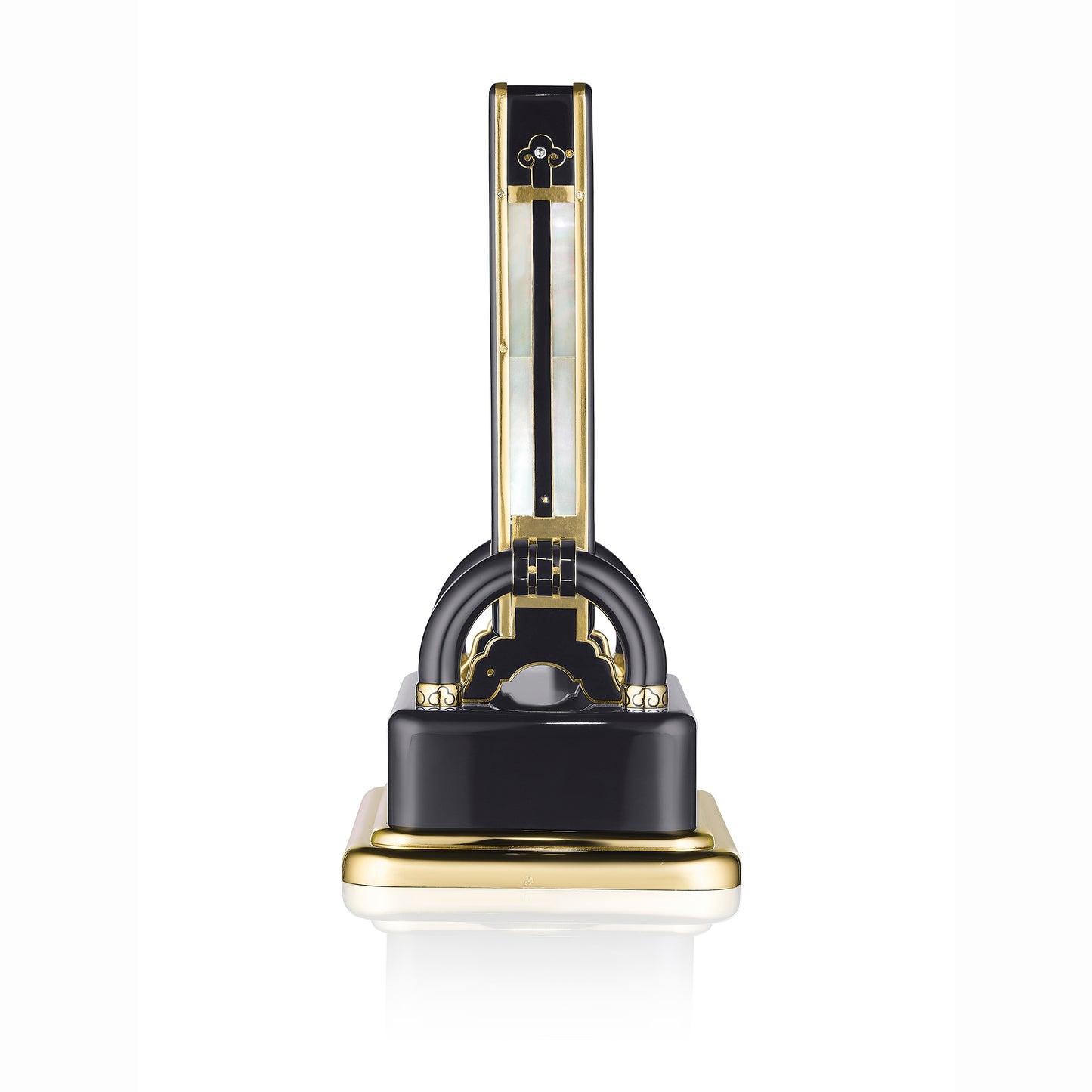ART DECO ONYX, ENAMEL, CORAL AND DIAMOND ÉCRAN CLOCK BY CARTIER, PARIS, 1926
ART DECO ONYX, ENAMEL, CORAL AND DIAMOND ÉCRAN CLOCK BY CARTIER, PARIS, 1926
Sold
A screen clock with a mother-of-pearl dial in a star pattern with diamond-set Roman numerals and hands outlined in black enamel trim, the hour hand in the form of a fan, the clock face with coral baton borders and outlined in black enamel, mounted on black enamel arches set in gold, on an onyx and gold base; with original key; with French assay marks; in a Cartier box]
- 369 rose-cut diamonds; total weighing approximately 2.09 carats
- Signed Cartier on the dial, base numbered 0459, key numbered 1414, movement signed Longines and numbered 27401414 and 2978566
- Measurements: 5 3/4 x 4 3/8 x 2 7/8 inches
Additional cataloguing
Certification
Cartier Certificate of Authenticity, No. GE2006-187 stating the clock is “Cartier Paris 1926.”
Literature
cf. Davis, Sarah, et. al. Jeweled Splendors of the Art Deco Era: The Prince and Princess Sadruddin Aga Khan Collection. New York: Thames & Hudson, 2017, pp. 103 & 235.
cf. Nadelhoffer, Hans. Cartier: Jewellers Extraordinary. London: Thames & Hudson, 1984, p. 218, pl. 58.
Biography
Cartier was founded in Paris in 1847 by Louis-François Cartier. His three grandsons, Louis, Pierre, and Jacques, built the house into a famous international jewelry empire serving royalty, Hollywood stars and socialites. Cartier has created some of the most important jewelry and objects of art of the twentieth century with many iconic designs such as mystery clocks, Tutti Frutti jewelry and the Panthère line. In 1983, The Cartier Collection was established with the objective of acquiring important pieces that trace the firm’s artistic evolution. Today, Cartier has 200 stores in 125 countries.
Significance
Clocks that do more than just tell time have fascinated connoisseurs for centuries. Singing bird boxes, automatons, and Jean Eugène Robert-Houdin’s pendules mystérieuses captured the imagination of an eager clientele in the nineteenth century. It would take another century before clocks again achieved a similar level of inventiveness. In the second decade of the twentieth century, Louis Cartier collaborated with Maurice Coüet to create clocks that seemed to defy natural laws: in some the hands moved without any visible operating mechanism, others were set neatly into flat cases perched on tiny legs. These new inventions mesmerized viewers with artistic magic in the ingenuity and craftsmanship that created the clocks.
The écran pendule or Screen Clock was one of the iconic Cartier designs of the Art Deco period, identifiable by the use of a rectangular clock accented with coral or hardstone batons above and below and arched legs connecting to the base in onyx or black enamel and gold. This style appeared in 1922 and was made into the 1930s. The form is based on the Chinese table screens used by scholars in the Ming and Qing dynasty (1368–1911). Interested in the arts, painting, and music, as well as law, literature, and theory, these scholars surrounded themselves with luxurious contemplative objects, made to give the eye something beautiful to assist the meditative mind. The table screen could be placed by a window or on a desk, originally to shield the scholar and his ink and paper from the breeze or the sun, but beside this practical function the screens were magnificent works of art.
The screen form lent itself to Cartier’s adaptation into a clock that is also both beautiful and functional. Further referencing the Asian influence, is the stylized ruyi fan used for the hour hand and repeated around the gold feet of the arches. (The ruyi is an auspicious symbol meaning “as you desire.”) Where the Chinese table screens were often delicate, this clock reflects the bolder Machine Age aesthetic that came out of the technological advances of the time, as can be seen in the pipe-like form of the arches with gold and enamel brackets and fittings. This rare and magnificent clock would be an important addition to any collection.













